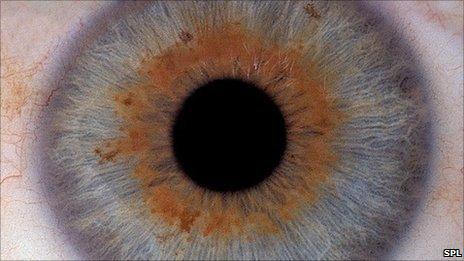Age related macular degeneration clue discovered
- Published

An international team of researchers has found a clue to one of the leading causes of blindness, which they hope could eventually lead to a cure.
Age-related macular degeneration affects 500,000 people in the UK and is incurable.
The study in the journal Nature, external found an enzyme known as DICER1 that stops functioning, resulting in the illness.
UK experts said it had the potential to be an important breakthrough.
The macula is a part of the eye which sits in the centre of the retina and is responsible for the fine detail at the centre of the field of vision.
As the disease progresses that central vision declines, making reading, driving and recognising people difficult.
It affects one in 50 people over 50 and one in five people over 85.
The exact cause is unknown, but risk factors include smoking, high blood pressure and having relatives with the condition.
Potential breakthrough
The researchers noticed the enzyme DICER1 was less active in the retina of people with the more common "dry form" of the illness and when they turned off the gene which makes the enzyme in mice, then the animal's retina cells were damaged.
It was then discovered that DICER1 is necessary for destroying small pieces of genetic material called Alu RNA.

Loss of sight with macular degeneration
Without DICER1, the Alu RNA accumulates with toxic consequences leading to the death of the retina.
Professor Jayakrishna Ambati, from the University of Kentucky, told the BBC: "This work opens many new doors of research.
"First, we need to identify various classes of molecules that can either increase DICER1 levels or block Alu RNA so that these can be evaluated in clinical trials.
"Second, we need to understand more about the biological processes that lead to reduction in DICER1 levels and the precise source of the Alu RNA transcripts."
Professor Ian Grierson, school of clinical sciences at the University of Liverpool, said: "This is a great piece of science which provides another jigsaw piece which we need to put together with other findings.
"It was done in an animal model which is a long way from the patient, the breakthrough is we've got another player."
Professor Mike Cheetham, head of molecular and cellular neuroscience at UCL, said: "It's a potentially very important breakthrough which gives insight into this dry form of the disease.
"It could provide new pathways to therapy, but the findings need to be validated by other researchers."
Cathy Yelf, spokesperson for the Macular Disease Society, said: "This is a very interesting piece of research and provides us with another valuable piece of the AMD jigsaw.
"It will not change a thing for patients immediately but it may lead to new treatments in the long term."
- Published3 November 2010